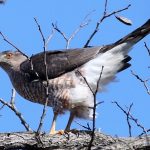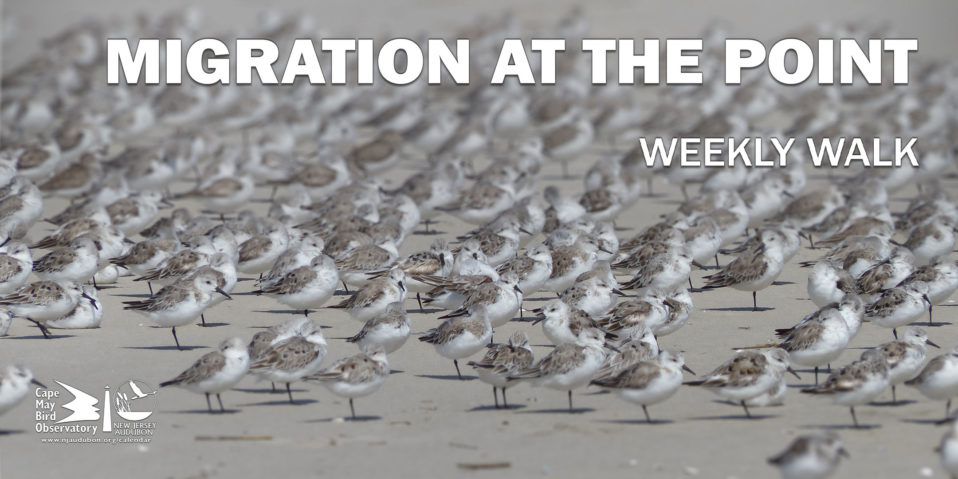The recent return of a wintering flock of Sandhill Cranes to the vicinity of Zarephath, Somerset County, has sparked an interest in the increasing frequency with which the species is being found in New Jersey, even during the breeding season. The past few months have seen other sightings from Atlantic, Burlington, Cape May, Gloucester, Passaic, Sussex, and Warren counties. In addition to the wintering birds, there has been a resident group of Sandhill’s, including some Sandhill x Common crane hybrids, in Salem and Cumberland counties for more than twenty years. This history of this flock, which now numbers several dozen and seems to have split into two separate parties, was described in an article we wrote for New Jersey Birds in 2009 (see below).
As described in our earlier article, a few cranes, apparently nesting, continue to be seen in the New Egypt, Ocean County, area. The presence of an apparent hybrid in 2003 and 2006, suggests that they may have come from the Cumberland flock. In a new development, the past two years have seen the attempted nesting of a pair at Walkill NWR in Sussex County. In 2019, the pair laid eggs which failed to hatch, but in 2020 the couple were photographed with two very young chicks. Unfortunately, the chicks did not survive, but the parents renested and successfully fledged two young. The pair remain in the area and will probably try again in 2021.
A look at eBird reports of Sandhill Cranes in the state from April to August in the past ten years shows an ever-increasing number of sightings. As Susan Treesh wrote in a recent post on Jersey Birds, “Reports of sandhills have been so widespread this year that surely multiple breeding populations will follow….” Great Swamp NWR and Dennis Creek WMA are two sites where pairs or individuals have lingered well into the nesting season and there are probably numerous other potential locations.
When a pair of Sandhill Cranes was discovered on a farm field in Franklin Township, Somerset County, earlier this year, the internet-based Jersey Birds list server was busy for many days with reports of the birds and questions about their location. After a couple of weeks, however, one subscriber asked why there was so much excitement about a pair of cranes when New Jersey has had a resident flock of Sandhill Cranes for several years. In fact, New Jersey has had a resident flock of cranes in Cumberland County for more than a decade, but they are not just Sandhills.
On February 15, 1993, George and Valerie Nixon discovered a Common Crane along Compromise Road in Salem County, NJ. Several days later, Bill Boyle and other viewed the bird through a Questar telescope and could clearly see a deformed middle toe on the left foot (Photo 1, Photo 2). After Laurie Larson posted a message about the bird on BirdChat (the first internet forum for birds in North America), she received an inquiry from Ben Burtt from Syracuse inquiring about it and providing the background on a Common Crane that had escaped captivity in New York. When Laurie informed him of the crooked toe, he confirmed that it was the same bird (Larson 1993, personal communication from B. Burtt).
Almost two years earlier, on a Saturday night in April 1991, Bill Boyle received a phone call from Tom Burke, the voice of the New York Rare Bird Alert. A Common Crane had been discovered that day near Red Hook, Dutchess County, New York. Needless to say, a quick trip was arranged and the bird was located and viewed the following day. Unfortunately, we soon learned that the bird had escaped from a private farm near Binghamton, about 75 miles to the southwest. This identification was confirmed by the presence of a deformed middle toe on one foot. The crane lingered in the area for two weeks, and then disappeared, only to reappear three months later near Onondaga Lake in Syracuse for a one-day visit.
Two months passed until the Common Crane showed up October 12 on the eastern shore of Otisco Lake, about 20 miles southwest of Syracuse and only about 60 miles from its starting point. Three days later it departed, only to return on January 12, 1992 for a single day. One month later, the crane was discovered in a field south of Seneca Falls, another 30 miles to the west. After a few days, the bird departed and was not seen for nearly one year.
When the Common Crane showed up in the Syracuse area, it caught the attention of Ben Burtt, a retired chemistry professor who wrote a weekly bird column for a local newspaper. It is to Ben that we owe the thorough documentation of the cranes origin and subsequent peregrinations. He contacted the farmer and learned the bird’s history.
The itinerant Common Crane was hatched in 1988 on a “Crane Ranch” near Binghamton from an egg imported from Europe. It was kept in a pen for the first 18 months of its life, but one day escaped from the pen. Efforts to recapture it failed, but the bird was injured during one of these attempts, badly damaging the middle toe on one foot. It remained around the farm, flying freely, until the spring 1991, when it circled high above and took off, never to be seen there again.
After the discovery of the crane is Salem County, numerous people rushed to see the bird, only to find out later that it was an escape. Ward Dasey subsequently learned from local people that the crane was first seen after a storm on December 11, 1992 (Dasey 1993). It lingered for several months, then there we no reports of it until the winter of 1994-95, when a Common Crane, presumably the same, wintered at nearby Mannington Marsh. Interestingly, a mixed pair of Sandhill and Common Cranes displayed courtship behavior and were present from June 2 to August 11, 1993, at Lowville, NY, only 60 miles northeast of Syracuse (Paxton et al. 1993).


During the summer of 1995, a Sandhill Crane x Common Crane (presumably the 1993 bird) pair nested successfully near Seeley, Cumberland County, about 10 miles southeast of Compromise Road. The following year, the two juveniles from 1995 assisted the pair in raising another brood at the same place, but after 1996 that site was apparently abandoned (Walsh et al. 1999). The birds remained in the area, however, and were photographed by local birder Ed Bruder with two chicks during this time (Photo 4). Nothing more was made public about the cranes until April of 2000, when Laurie Larson and Jim Williams visited Bostwick Lake, just north of Seeley on the Salem-Cumberland county line, and saw and heard three “cranes” flying over, bugling. Laurie contacted long-time Cumberland birder Bob Barber, who related that he had heard and seen cranes in that area every spring since 1995. Later in summer of 2000, various birders encountered a mixed pair of Sandhill and Common cranes with a single juvenile. Conversations with local residents revealed that the birds had “been around for years and they’re here all the time.”


By early 2001, there were 9 cranes frequenting Bostwick Lake, two apparently pure Sandhills and the rest hybrids, as shown in the photo by Steve Kerr (Photo 5), but the Common Crane was not reported that year, or during the following six years. In December 2002, while participating in the Cumberland Christmas Bird Count, Paul Guris and colleagues found the 9 cranes at their evening roost on Husted Landing Road, about 12 miles south of Bostwick Lake. For the next several years, they continued to find the cranes there while conducting the annual CBC. In 2003, there were only five, but nine were counted in both 2004 and 2005, and 14 were present in 2006 (Sutton 2007). As before, the flock appeared to be a mix of apparently pure Sandhill Cranes and hybrids. Local resident Peter Jespersen confirms that the flock uses the area as a winter roost. The show up in late October and depart in February.

On December 30, 2007, Guris and company found 16 cranes, including, for the first time, one that appeared to be pure Common Crane. Tony Croasdale followed up on January 20, 2008, and was able to view the 16 cranes at fairly close range. When they took flight, Tony observed that the Common Crane did not appear to have a deformed toe. Howard Eskin photographed the flock in February 2008 and also concluded that the Common Crane had a normal foot. His photos show that many of the birds in that flock have some mixed parentage in their background, the most obvious point being the presence of black on the fore-crown, where a Sandhill Crane has only red (Photos 6-11).




As of early 2009, the resident flock of cranes continues in Cumberland County. Although we will never know for certain, it seems highly likely that most of the members of this group are descendants of the original mixed pair of old “Crooked Toe”, the escaped Common Crane, and its partner, a wild Sandhill Crane. This could probably only be established through DNA analysis. The flock may have recruited an additional Sandhill Crane or two, since migrant Sandhills occasionally winter in the state, but where they picked up the new Common Crane is a mystery. It is possible that the apparently “pure” Common Crane now present is a result of inbreeding and back-crossing within the flock, although all of the presumed hybrids resemble Sandhill Crane much more closely than Common Crane.
Adding further mystery to the story of the cranes of southern New Jersey is the more recent appearance of a small flock near New Egypt in Ocean County. Two Sandhill Cranes were first noted December 19, 1999, near Cream Ridge, Monmouth County, on the Assunpink Christmas Bird Count (Barnes 2000). They proved to be elusive, but stayed around for at least a month. According to a local goose hunter, that was the “third or fourth year” that the birds were around. Interestingly, three “probable” Sandhill Cranes had been noted April 10, 1997, near Archertown, Ocean County, only x miles south of Cream Ridge (Vernachio 1997).


A pair of Sandhill Cranes was present at New Egypt in October, 2001, and March, 2002, a pair (presumably the same) was suspected of nesting at Fort Dix, just south of New Egypt, during the summer of 2002. The following spring, an apparent hybrid (Sandhill x Common) crane was observed in the area for two months and two birds were seen off and on throughout the year. The birds continued to be seen off-and-on in the New Egypt area for the next several years, often along Long Swamp Road on the Jumping Brook Preserve of the National Biodiversity Parks organization. This site is adjacent to Fort Dix and only a couple of miles west of Colliers Mills Wildlife Management Area.
Over the years, there has been some discussion as to whether or not the New Egypt pair were hybrids or not, but a photo taken by Alex Tongas on March 5, 2006 (Photo 12), shows the black fore-crown typical of a hybrid Sandhill x Common. As of early 2009, the birds (exact number unknown) continue to be seen occasionally in this northwestern corner of Ocean County.

By
William J. Boyle, Jr., and
Laurie Larson
Literature Cited
Barnes, S. 2000. Winter Field Notes. Records of New Jersey Birds 26:75.
Dasey, W. 1993. Winter Field Notes. Records of New Jersey Birds 19:45.
Croasdale, T. 2008. Common Crane, Sandhill hybrids-Husted Landing, Cumberland County. Posting on Jersey Birds, January 20, 2008.
Guris, P. 2008. Crane Flock (incl. poss. pure Common Crane) in Cumberland County. Posting on Jersey Birds, January 2, 2008.
Paxton, R.O., W. J. Boyle, Jr., and D.A. Cutler 1994. Hudson-Delaware Region. American Birds 47:1093.
Sutton, P. 2007. Sandhill Cranes arrive at dusk to roost in the marsh at Husted Landing Road. Posting on Jersey Birds, January 20, 2007.
Tongas, A. 2006. Photograph in New Jersey Birds 32:54.
Vernachio, B. 1997. Spring Field Notes. Records of New Jersey Birds 23:66.
Walsh, J., V. Elia, R. Kane, and T. Halliwell. 1999. Birds of New Jersey. New Jersey Audubon Society, Bernardsville.











